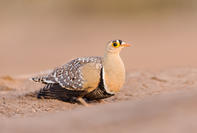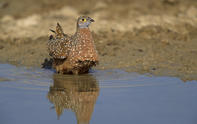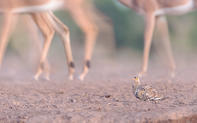Matching Attire
Sandgrouse are superbly cryptically-coloured ground birds and they choose to sit-up on open sandy habitats that perfectly match their attire. They nest in particularly open areas for the same reason, the monogamous male and female sharing incubation duties and concealing their eggs with their own cryptic bodies.
Because of the hot nature of their habitats, sandgrouse have developed some unique traits. They have densely packed feathers and thickened skin and scales on their feet. Most uniquely, the feathers on the belly of the male bird are modified for collecting and retaining water.
The birds visit waterholes at sundown to drink weaving through the trees to escape attention until they alight at the water's edge. Here the male will wade into the shallows and raising the feathers on his upper belly will allow them to soak up water in a process known as ‘belly-wetting’. These belly feathers are then flattened again before he leaves to return to the nest. Sandgrouse chicks drink the water directly off their father’s feathers.
Double-banded Sandgrouse are seed-eaters and they typically exploit the ephemeral (temporary) abundance of annuals’ seeds. Remarkably, the chicks feed exclusively on hard seeds right from hatching and are the only birds in Africa, and most of the world, to do so.
By Megan Emmet



 Burchell's sandgrouse have light brown to rufous plumage, that is mottled with dark brown and white spots....
Burchell's sandgrouse have light brown to rufous plumage, that is mottled with dark brown and white spots.... Double-banded sandgrouse generally have light brown plumage, with rows of white specks and some darker mottling....
Double-banded sandgrouse generally have light brown plumage, with rows of white specks and some darker mottling.... Namaqua sandgrouse have light brown plumage, with rows of white specks and some darker mottling....
Namaqua sandgrouse have light brown plumage, with rows of white specks and some darker mottling....